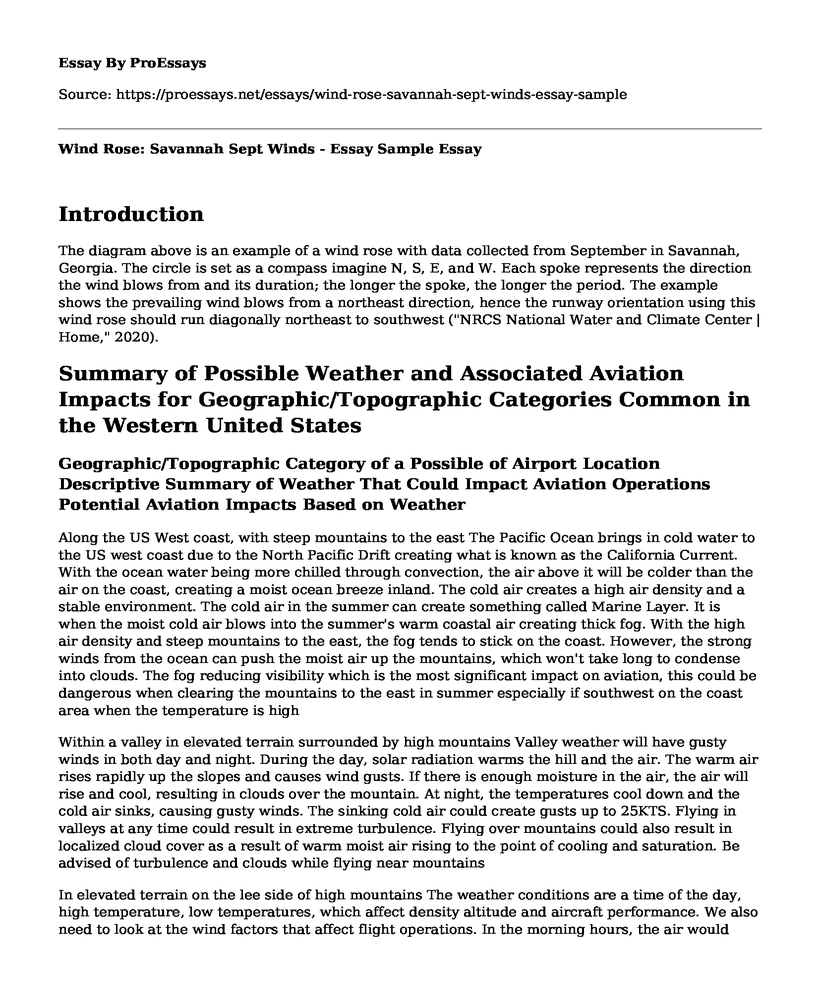Introduction
The diagram above is an example of a wind rose with data collected from September in Savannah, Georgia. The circle is set as a compass imagine N, S, E, and W. Each spoke represents the direction the wind blows from and its duration; the longer the spoke, the longer the period. The example shows the prevailing wind blows from a northeast direction, hence the runway orientation using this wind rose should run diagonally northeast to southwest ("NRCS National Water and Climate Center | Home," 2020).
Summary of Possible Weather and Associated Aviation Impacts for Geographic/Topographic Categories Common in the Western United States
Geographic/Topographic Category of a Possible of Airport Location Descriptive Summary of Weather That Could Impact Aviation Operations Potential Aviation Impacts Based on Weather
Along the US West coast, with steep mountains to the east The Pacific Ocean brings in cold water to the US west coast due to the North Pacific Drift creating what is known as the California Current. With the ocean water being more chilled through convection, the air above it will be colder than the air on the coast, creating a moist ocean breeze inland. The cold air creates a high air density and a stable environment. The cold air in the summer can create something called Marine Layer. It is when the moist cold air blows into the summer's warm coastal air creating thick fog. With the high air density and steep mountains to the east, the fog tends to stick on the coast. However, the strong winds from the ocean can push the moist air up the mountains, which won't take long to condense into clouds. The fog reducing visibility which is the most significant impact on aviation, this could be dangerous when clearing the mountains to the east in summer especially if southwest on the coast area when the temperature is high
Within a valley in elevated terrain surrounded by high mountains Valley weather will have gusty winds in both day and night. During the day, solar radiation warms the hill and the air. The warm air rises rapidly up the slopes and causes wind gusts. If there is enough moisture in the air, the air will rise and cool, resulting in clouds over the mountain. At night, the temperatures cool down and the cold air sinks, causing gusty winds. The sinking cold air could create gusts up to 25KTS. Flying in valleys at any time could result in extreme turbulence. Flying over mountains could also result in localized cloud cover as a result of warm moist air rising to the point of cooling and saturation. Be advised of turbulence and clouds while flying near mountains
In elevated terrain on the lee side of high mountains The weather conditions are a time of the day, high temperature, low temperatures, which affect density altitude and aircraft performance. We also need to look at the wind factors that affect flight operations. In the morning hours, the air would more stable air due to weak vertical mixing turbulent air of air resulting in no gusts of wind. Later in the afternoon time, there is solar heating, which creates upslope winds on the windward side, which creates Chinook Winds, which pushes air up the mountain and then condenses and loses moisture, the drier warm air descends and warming by compression lowering humidity. Which causes air instability and steady eddies resulting in extensive vertical mixing and turbulence with the possible Clear Air Turbulence and sharp vertical wind shears. If enough moisture is present billow rotor and lenticular clouds can form, which are visual signals of the presence of turbulence on overcast days, there will less heating causing weaker vertical mixing, turbulence, and wind gusts. Higher temperatures will cause less dense, producing a higher density. Lower temperatures would cause the air to be thicker with the possibility of low-level icing conditions. Potential impacts are that cloud cover could reduce ceilings over mountains and reduce visibility. Steady eddies and rotor waves will cause extreme turbulence and sharp vertical wind shears. Depending on the runway heading, there could be westerly crosswinds. As the temperature rises, there will be reduced aircraft performance due to high-density altitudes, causing a need for a longer runway. Dropping temperatures could causing low-level icing.
References
NRCS National Water and Climate Center | Home. (2020). Retrieved 24 March 2020, from https://www.wcc.nrcs.usda.gov/climate/windrose.html
Cite this page
Wind Rose: Savannah Sept Winds - Essay Sample. (2023, May 02). Retrieved from https://proessays.net/essays/wind-rose-savannah-sept-winds-essay-sample
If you are the original author of this essay and no longer wish to have it published on the ProEssays website, please click below to request its removal:
- Environmental Impact of Personal Lifestyle: Throwing Litter Essay
- Mosquito Mess in Ocean Side Community Paper Example
- Climate Change: Essay Sample
- What I Think Every Academic Should Know Essay Example
- How Global Warming is Not Caused by Humans?
- Rise in Disasters: Technological Advances Altering Communication - Essay Sample
- Paper on Climate Change and Species Redistribution: Impacts on Human Prosperity and Ecosystem Management







